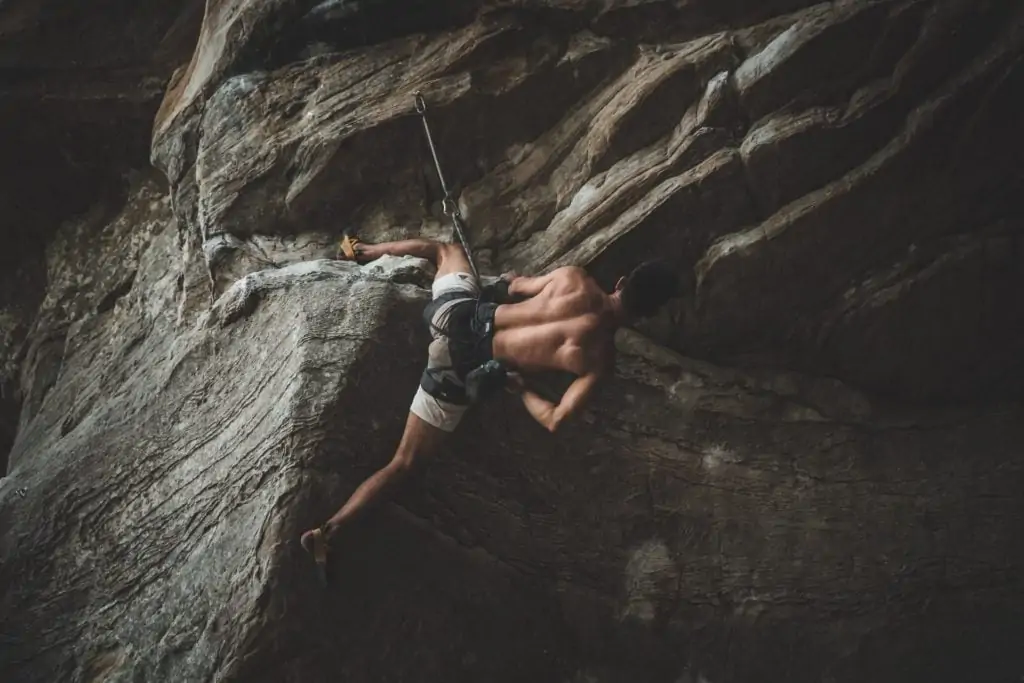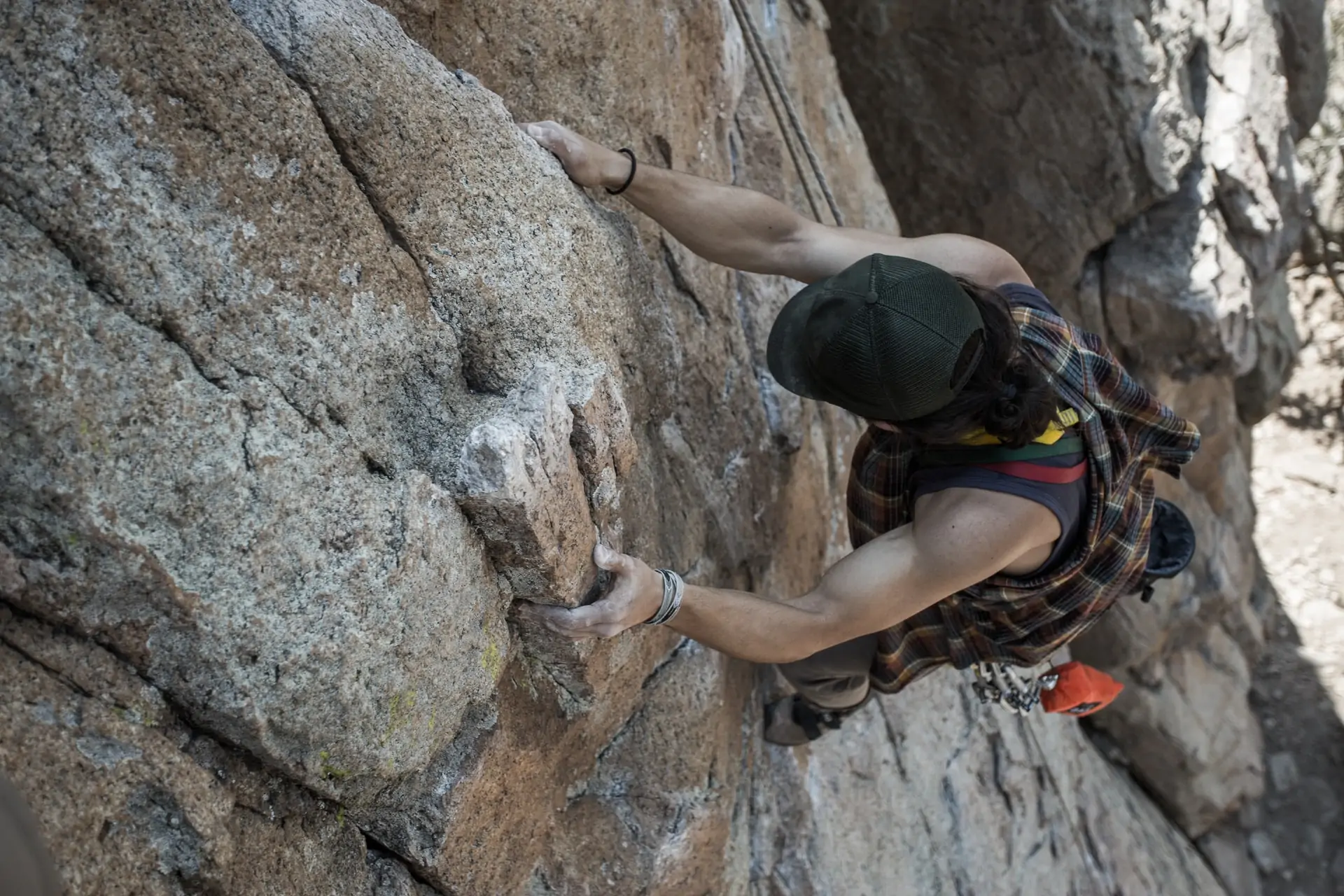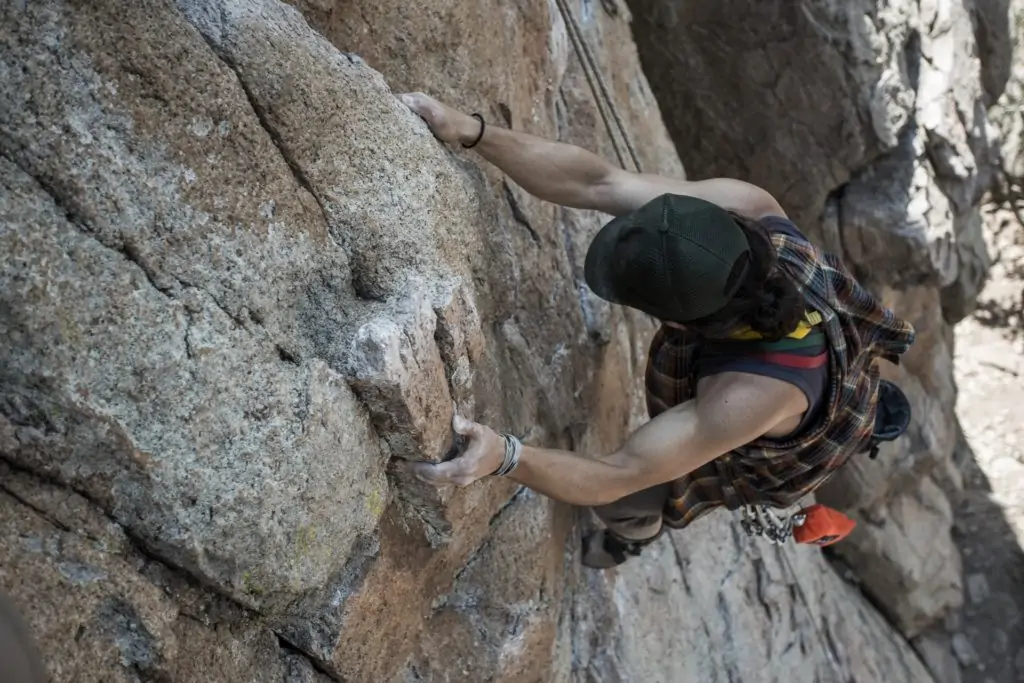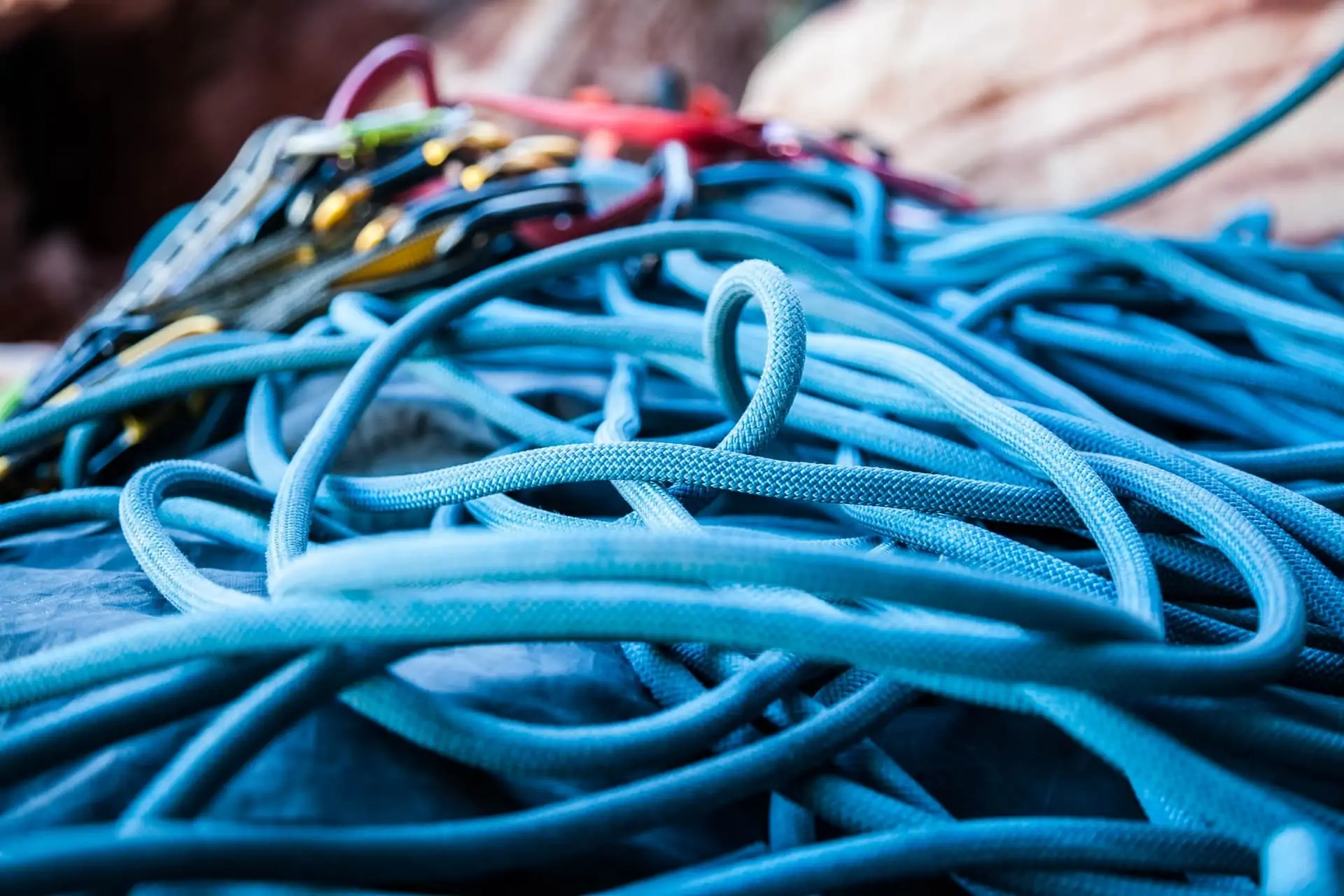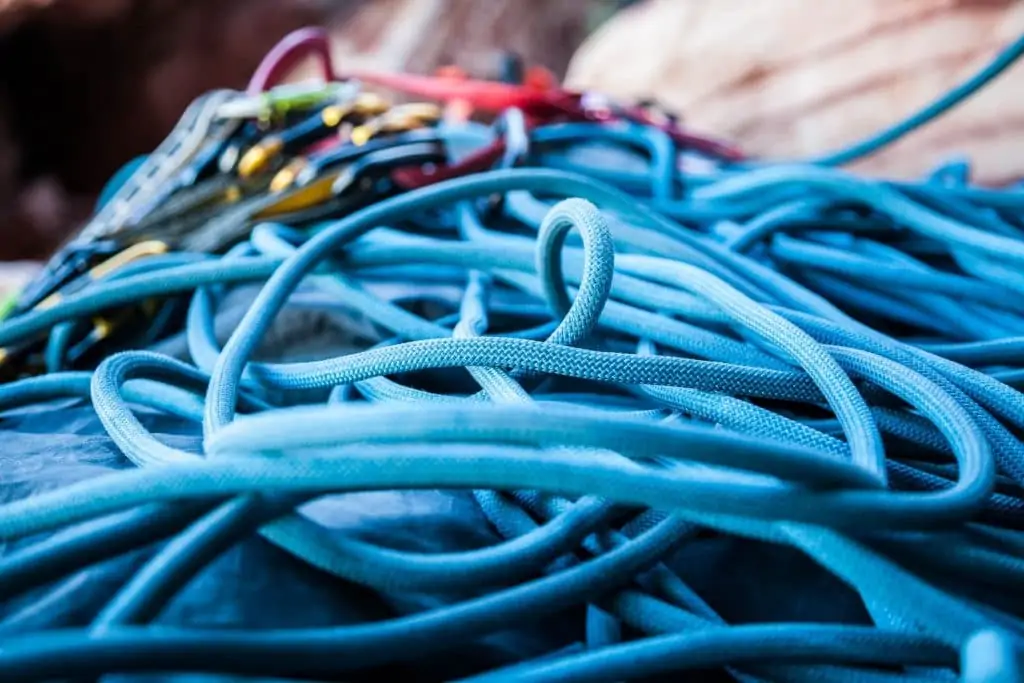Imagine that your friend just told you that they started climbing, you would have no idea if they meant bouldering or rock climbing as both often fall under the umbrella term of climbing. Maybe you didn’t even know that there were different types of climbing. You have come to the right place! We’ll break down some of the most common forms of climbing and talk through the differences between rock climbing and bouldering.
 What are the Different Types of Rock Climbing?
What are the Different Types of Rock Climbing?
Under the broad category of rock climbing, there are many, many disciplines. We’re going to talk about some of the most common here.
What is Bouldering?
Bouldering is climbing rocks or boulders that are under about 20 feet tall. Your only protection is a crash pad on the ground below you and a friend spotting you if you fall. Bouldering requires very little gear, with shoes and a crash pad being the only real essential gear, but chalk does help quite a bit.
If you go bouldering over 20 feet, but under 50 ft, it’s called highballing. Bouldering gets more and more dangerous the higher up you climb. The sport is often characterized by short, hard moves utilizing heel hooks, toe hooks, dynamic moves (dynos), and a variety of other hard and risky moves.
Bouldering is typically said to rely more on strength, while rock climbing relies more on endurance.
Bouldering routes are called problems and are rated on the V scale. This scale starts at V0 and increases numerically in difficulty to V17. In general, grades are very subjective and will vary significantly between locations and gyms, but can give you a general idea of how hard or easy a problem will be.
What is Rock Climbing? (Top Rope, Sport, Alpine, Free, etc.)
Rock climbing is climbing rocks higher than bouldering. There isn’t a definitive line where a climb switches from bouldering to rock climbing, as what some people might highball, others will want a rope. Rock climbing routes can range in height from 30 feet to over 3000 feet, depending on how many pitches of climbing it is. (A pitch is from the ground to anchor or from one anchor to the next; basically the distance you would climb on one rope)
Rock climbing is graded using the Yosemite Decimal System (YDS) in the US, but there are other grading systems used across the world. The YDS ranges from 5.0 through 5.9, by whole numbers. Starting with 5.10, the grades are broken down more into subcategories using letters, so 5.10a would be easier than 5.10b.
In theory, the difference in difficulty between a 5.10a and a 5.10b should be the same jump in difficulty as between a 5.7 and a 5.8, but grades are subjective and tend to vary between locations and gym. They will give you a good general idea of how hard or easy a route will be.
Rock climbing can be broken down into many categories, all of which require different amounts of gear, can be done in different places, and range in popularity. Some of the main types of rock climbing include top rope, sport climbing, trad climbing, alpine climbing, deep water soloing, ice climbing, and free soloing. Check out the difference between climbing and bouldering grades here.
Top rope climbing is where the climber is attached to a rope, through an anchor at the top of the climb, and back down to the belayer. As the climber goes up the climb, the belayer takes the slack out of the rope so that if the climber falls, they will only stretch on the rope and not hit the ground or any ledges. This style of climbing is popular both in gyms and outside and is often how many people start out rock climbing. It requires shoes, a belay device, a rope, an anchor set-up, and a friend.
Sport climbing is a style of lead climbing, where the climber is tied into one end of the rope and clips the rope into fixed protection on the wall as they go up. The belayer is both giving slack and taking slack, so they don’t pull the climber off the wall, but they can catch a fall if needed. Sport climbing leads to more substantial falls than top-rope climbing, but if you are able to lead sport, you can climb at more crags than if you could only top rope. It requires the same gear as top-roping and quickdraws, used for clipping the rope into the fixed protection.
Trad climbing is similar to sport climbing in that it is a form of lead climbing, but instead of having fixed protection on the wall already, you place protection in the wall as you go up. A trad climber uses active protection (camming devices) and passive protection (nuts and hexes) to help protect themselves from long falls as they go up the climb. Trad climbing requires the same gear as sport climbing and a trad rack, which is the active and passive protection pieces.
Alpine climbing is a mixture of hiking, trad climbing, and oftentimes ice climbing. The goal of alpine climbing is to reach the summit of a mountain. This style of climbing usually requires lots of gear, training, and time. The risks associated with alpine climbing can be very high, depending on what peak you are trying to summit and can be everything from altitude illnesses to avalanches. Alpine climbing is only done outdoors and can’t be practiced in a gym, although many of the skills you need can be practiced in gyms or at smaller climbing crags.
Deepwater soloing is a very specific style of climbing where you climb long routes with no ropes, belayer, or protection, but are over deep water. That way, if you fall, you fall into the water down below. Deepwater soloing can only be done in very specific locations where the cliffs go straight down into deep water. Although it doesn’t require much gear, it can be very hard on the gear that you do use, due to being dunked in water all the time.
Ice climbing is using crampons and ice tools to dig into glacial or waterfall ice and to climb up it. Ice climbing can be done either as top rope or as lead, using ice screws into the ice for protection. Overall, it requires a massive amount of gear and training and can only be done in specific places at specific times of the year. We won’t be talking much about ice climbing, but we thought it was good to bring up as a type of climbing.
Free soloing is climbing tall routes with no rope, no protection, no anchor, nothing but you, your shoes, and the rock. This style of climbing is extremely dangerous and is not very common due to the high level of risk. It was shot into the public view by Free Solo, the movie about Alex Honnold and his free solo of the Nose of El Cap. Free soloing doesn’t require much gear, but it does require a lot of courage.
Overall, rock climbing is often broken into free climbing (different from free soloing) and aid climbing. The most common styles of rock climbing are top-rope climbing, sport climbing, and trad climbing. All of these styles are what is known as free climbing, or only using the features of the rock face to get up.
This is contrasted with aid climbing, which requires lots of training and gear. It utilizes gear as aid pieces that are pulled on or stepped on to assist the climber in getting up the rock face.
Why do People Like Bouldering or Rock Climbing More?
People tend to like either rock climbing or bouldering more depending on a variety of factors in their lives. For some people, cost is a huge factor, and bouldering is significantly cheaper than rock climbing.
For other people, accessibility may be the main factor. If you live near rock climbing or bouldering, but not the other, that may make your choice for you. There are a variety of reasons why you might like rock climbing or bouldering more.
One of the significant differences between rock climbing and bouldering is the height involved. For some people, the height is a good thing; they enjoy the rush of being hundreds of feet in the air. They might prefer rock climbing. Other people are terrified of heights and don’t want to go very far off the ground at all. They might prefer bouldering.
Another consideration is what type of strength is associated and involved with rock climbing and bouldering. In general, rock climbing is associated with more endurance-based strength, while bouldering is associated with more power-based strength. These things are not totally exclusive though, and both do rely some on endurance and some on power, but people who tend to like endurance sports, may be more inclined towards rock climbing, while people who tend to like power sports, may be more inclined towards bouldering.
What do People Dislike About the Different Types of Climbing
Similar to what people like about rock climbing or bouldering, each has its own drawbacks and downsides. One of the major drawbacks of rock climbing is the cost. One of the major drawbacks of bouldering is the level of difficulty. The grading scale for bouldering is offset when compared to the grading scale used for rock climbing, meaning that an easy boulder (V0 or V1) is still hard when compared to a rock climbing rating (usually around 5.10)
The moves associated with rock climbing tend to be easier when starting out, but cost more to initially purchase the gear. Rock climbing also tends to have a steeper learning curve, especially when it comes to the safety components of rock climbing.
On the other hand, the moves associated with bouldering tend to be harder when you’re first starting out, especially at outdoor boulders. Many new climbers find the difficulty to be discouraging.
Which Type of Climbing is Right for You?
Well, that depends on a lot of things. It depends on what’s accessible to you, how much time and money you want to invest, and who is around to help teach you. There is no one correct answer as to what the best kind of climbing is. Climbing is all about finding what excites you and what makes you want to keep pushing yourself and exploring more.
Maybe you live in an intercity with a super cool bouldering gym nearby; bouldering may be the right choice for you. Perhaps you live really far north and love the winter; ice climbing could be your new thing. Maybe you live near a fantastic outdoor climbing area, trad or sport climbing could be the best fit for you. It’s all about figuring out what’s available to you.
As with starting any new sport, there will be a learning curve.
We recommend taking a class at a local gym or climbing school or reaching out to a friend who climbs and asking for lessons. Rock climbing can be dangerous, and before you head off and start climbing everything you can find, you should make sure that you understand the safety aspects of the sport.
Take some time to learn how to belay properly or how to properly spot a climber falling. It could just save your life.
Is Bouldering Harder than Rock Climbing?
That depends on what you mean by harder. Overall, a boulder problem is shorter than a rock climb, so it should be easier. This is sometimes the case, but not always. As we’ve mentioned before, the rating system for bouldering starts at a V0. A V0 in bouldering is usually considered to be the equivalent of a 5.10 on the Yosemite Decimal System or the rating system used for rock climbing in the US. A 5.10 climb is not considered to be a beginner climb, so the moves on your first boulder problem may be more challenging than the moves on your first rock climb.
This doesn’t mean that all boulder problems are harder than all rock climbing routes. This depends on the specific routes and problems that you’re comparing, as well as how your body works. Some people find bouldering harder, while others find rock climbing harder. Often times, the one that is “harder” for someone, might just be the one that they aren’t drawn to as much, so it can seem to be uncomfortable and awkward movements at times.
Does Bouldering Help Your Rock Climbing?
Yes, bouldering can totally help your rock climbing. Many people have used boulder problems as a way to recreate the crux or hardest section of a long rock climb so that they can project or work on just the hardest moves. That way, climbers can get the flow of the moves down before they’re 75 feet up a climb, and they’re arms are already tired.
We talked earlier about the differences between rock climbing and bouldering in terms of power strength and endurance strength. While rock climbing does require more endurance, it does also need power, and that’s where bouldering can come in handy. Bouldering frequently is a great way to work on power and feel more comfortable on the wall or rock face before going out rock climbing on a big wall or face.
Wrapping Things Up: Bouldering vs. Rock Climbing
Whatever style of climbing you choose, be safe, and have fun! Despite the vast amount of differences, many climbers enjoy at least two or more of the styles of climbing that we talked about here.
Maybe you prefer bouldering, but your best friend loves sport climbing. Chances are that you can both do the other activity, especially since all of these different forms of climbing help train you for the other types. Get out there and try a new style. Who knows, it might become your new thing.
If you enjoyed this article, please also make sure to also check our other climbing tips here.
> 21 Advanced Bouldering Tips and Techniques
> 50 Rock Climbing Tips for Beginners and Intermediates

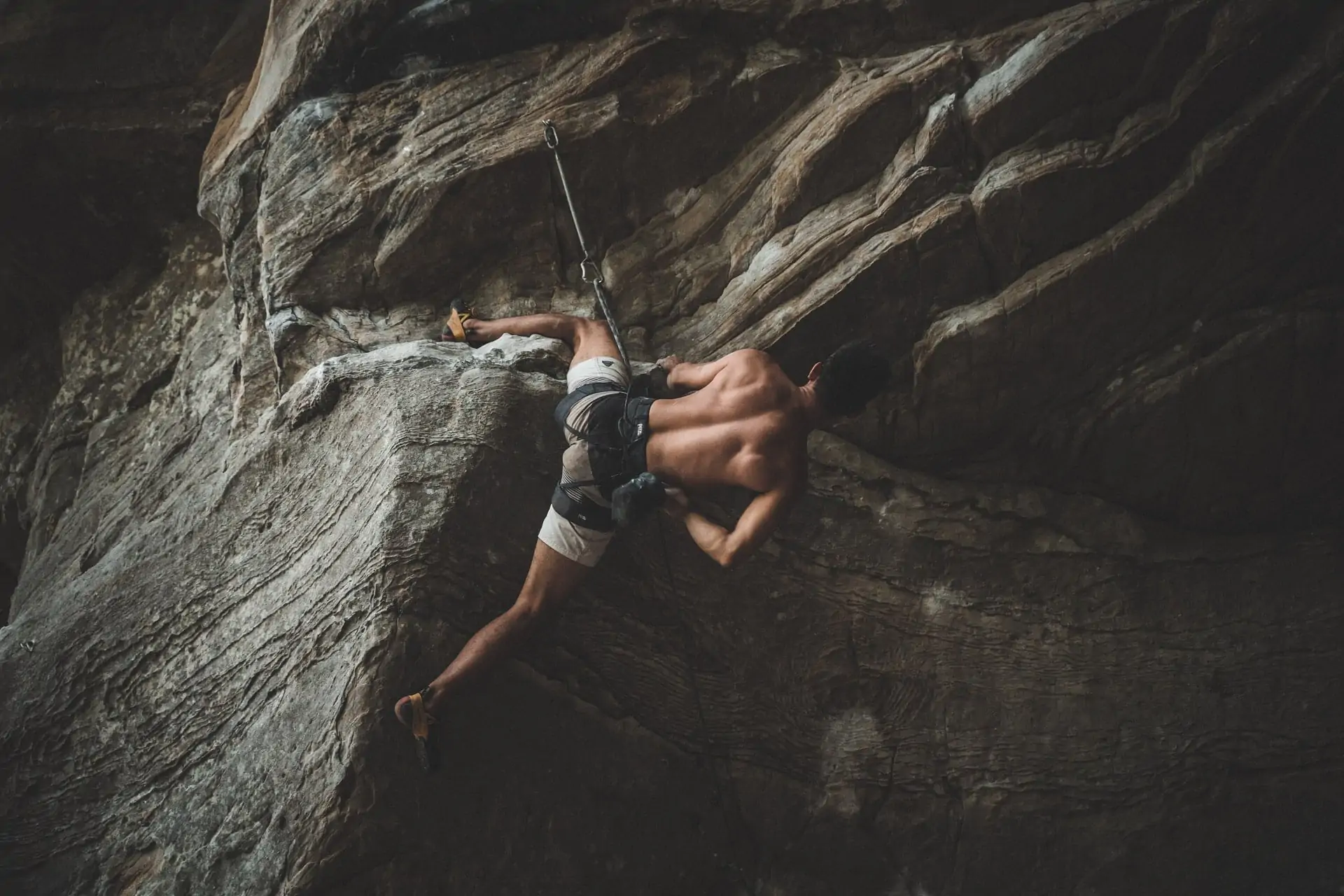 What are the Different Types of Rock Climbing?
What are the Different Types of Rock Climbing?